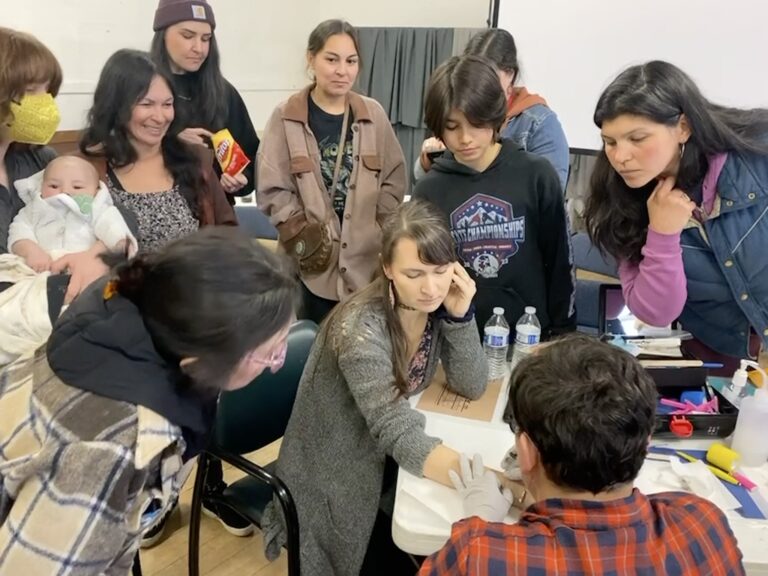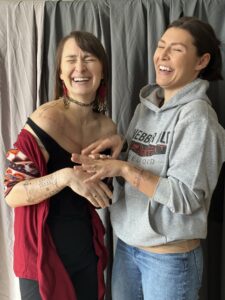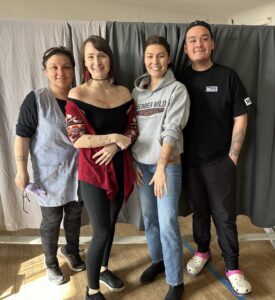Traditional Tattoo Revival
in Eyak (Cordova)
A Journey to What Matters Story by Teal Webber

Inupiaq artist and traditional tattoo revitalizer, Holly Nordlum, and her son and apprentice, Trevor Forrester, traveled to Cordova to offer tattoo appointments, allow two tribal women to “shadow” them during select appointments, and “hold space” for discussion with the community and CHS’s Alaska Native Arts class. Throughout their four-day stay in Cordova, the dynamic duo tattooed 19 tribal members and 3 community members, a total of 19 women and 2 men. Holly, having tattooed around a thousand women in the last decade, mentioned that my husband, Aaron Hansen, was around her 15th male client. This project was funded by The CIRI Foundation’s Journey to What Matters grant, a program focused on increasing Alaska Native art and culture.
On Thursday, Holly discussed traditional tattoo methods and processes at the high schools Alaska Native Arts class. She then drew traditional tattoo designs on most of the youth. That night and Friday night, she held a space for ICC Members to discuss these same topics, as well as introduce her artwork, tell a couple related stories, and shared her views on colonization and how she operates as a cultural revitalizationist, and why. Holly informed me that she does not “lecture or teach” classes, but she “holds space for discussion,” which was an unexpected but beautiful shift in our expectations. The environment was informal, welcoming, and filled with laughter – even resulting in laughing fits on the second night! The class also touched on several complicated topics, but hearing different perspectives and how experiences have shaped a person’s outlook and personal process is vital to understanding the diverse impacts on our indigenous populations. At the end of each night’s discussion, Holly gave a live tattoo demonstration in both the skin-sewing and skin-poking methods. I was the volunteer for the first night’s live demonstration, and several women received simple finger tattoos at the end of the second class, including my little sister Misa Webber, Kayley Babic, Anya Honkola, and Danaya Hoover.
After ICC was awarded this grant funding, the Cultural Department released an RFP (request for proposals) to our tribal members for Traditional Tattoo “Shadows,” as we’ve been calling them. Our aim with this opportunity was to simply offer an introductory experience into a field of interest to the tribal members most likely to continue this traditional artform, with the overall goal of repatriating this skill back to the descendants of the original stewards of our land. The grant project allowed for payment of two Shadows, whose requirements were: to be tribal members, had interest in the traditional tattoo process, and were able to treat this opportunity as a foundational and preliminary “career”-type training. Shadows attended at least four pre-approved tattoo appointments and were encouraged to ask questions and engage in the process, while remaining respectful and sensitive to the client’s transformative experience. Shadows, however, had no part in the physical act or process of tattooing. From the applications received, the ICC Committee concluded that Brooke Mallory and Kanisha Tiedeman Lohse were the best ladies for the job.
Brooke has since stated that she can’t wait to be Holly’s apprentice when the time is right. In response to her own tattoo appointment, Brooke said, “I can’t express how emotional the experience was getting a traditional tattoo with traditional methods. It felt so right. Things just kept clicking together like a puzzle.”
At the time of writing this article, Kanisha has since received her Bloodborne Pathogens certificate, is scheduled to get certified in CPR, has acquired basic tattoo supplies, has started her apprenticeship with Holly, and has slowly started tattooing simple dots and lines. Kanisha expressed feeling like her universe expanded and that she is a different person now. All it takes is one opportunity, one person, to change a person’s journey.
Kanisha’s response to her time as a Shadow can be felt by all: “Marking the body opens gates to remember soul-contracts. It is stored in the memory of our DNA. I am rekindling the marks (traumas and memories) inside me. Transforming those marks into body literacy. An atlas for learning the language that builds the story. Traditional markings of birth, renewal, and remembrance. I bring these markings to the altar of my body. I am honoring that story. With self-exploration and autonomy, we can cultivate and identify ourselves with traditional markings. When you are ready, the teacher appears. This is my feeling with Holly. I needed to hear her story. Holly brought a remembering to her gathering. A remembering of the soul-contracts with her people and ancestors. A soul-contract is an agreement to grow and learn as a soul. It’s our higher-self connecting with another. Hearing Holly say, “this is a spiritual practice,” was exactly what I needed to hear. I am a healer. I am a birth-worker. Birth is a spiritual practice that marks the body, mind, and spirit. Like traditional marking, I feel a deep connection to both these practices. What I learned with Holly is that being is becoming. As humans in society, we tend to reach outside of ourselves for answers, when the truest answer is already inside of us. It’s the colonization of cultures that puts us in boxes. It’s society that keeps us separated and individualized.
The natural world is out medicine, and it is inside us. We are students of life. There is a language to learn. Listen to the voice inside and remember to follow the language that speaks to you. When we pay attention, we are met with abundance and space to thrive. Finding this path with Holly gave me a new lens in which to see the world.”
Other comments from tribal members in response to their traditional tattoo experience:
Thomasina Andersen said, “I began to feel a longing to have something permanently on my body that I’d never felt before, something that would help carry forward a cultural tradition that came close to being lost. Now, it feels like [the tattoo] was always there, under the skin, waiting to come out.”
Denise Eleshansky mentioned that she “had one of the best healing moments” getting her marriage lines on her chin.
Raven Cunningham responded to her experience as a “sacred space hosting intimate markings that honor my culture, growth, and experiences I’ve had in my life. Thank you, Holly, for sharing your space with me.”
Danaya Hoover said, “This was such an incredible journey. What a truly special opportunity and experience. I am so grateful to have received these traditional markings by Holly. I loved every second of it and had so much fun laughing and sharing stories. Every time I look at my hands, I am grateful.”
Jessicca Hoover Jones and Holly quickly became thick as thieves. She asked, “Have you ever met someone you just knew you were meant to meet? Holly! I love her! We laughed, we shared our spirits, and then she marked me.”
Rachel Hoover-Blackwelder commented: “There are so many emotions to process after this experience, gratitude, sadness, and strength for the women who came before me. I am grateful for my bloodline. Thank you, Holly.”
My sister, Misa Webber, flew home from Dillingham for her tattoo. She stated, “The connectivity that Holly and Trevor brought to (especially) the women of our community was incredibly special. Western society has taught us to be competitive, different, and unique. Alternatively, our indigenous culture brings us together. I’m looking forward to sharing another traditional tattoo experience again in the future.”
My husband, Aaron Hansen, has many tattoos, several of which represent his Tlingit or Unangax̂ heritage, but this was his first experience getting a traditional tattoo by traditional methods and expressed feelings of “fulfillment” after his appointment.
Kayley DeLozier conveyed her gratitude to all those who helped make this opportunity happen. “This was a very sacred and healing experience for me. I felt safe and supported being tattooed by Holly and Trevor. Their energy brought something very special to our little fishing town. Growing up as a blonde Native in the 1990’s, I felt quite disconnected from my heritage, mostly due to how I looked. This experience helped me embrace my indigenous roots and honor them in a way I never have before. I am so grateful for this experience and will treasure it always.”
Tribal youth in CHS’s AK Native Arts class collectively remarked on how amazing and fun Holly was. Alice Graves said, “She is the kind of person that you meet for the first time but is so inviting and kind that it feels like you’ve known her for a lifetime.” Samantha Eleshansky mentioned that Holly “was welcoming and made class feel like a safe space.” Similarly, Ricki Riley said that Holly “was so funny and made everyone feel included.”
Before and during this time in April, I reached out to women in different communities who have received both skin-sewed and poked tattoos and asked if they preferred one method over the other. Every person seemed to prefer the sensations of being skin sewed over poked because the pain was more tolerable. Holly prefers tattooing in the poking method because it is easier, quicker, and she does not have to go through an experimental period of learning a person’s skin thickness/toughness or hydration levels, which all affect the skin sewing process. For example, my first appointment was mid-day on Thursday. Holly started with skin-sewing my earth line near my wrist. It was extremely difficult for her to get the needle through my skin and was even bending the needle. But later that night at class when I was the demonstration victim, I mean volunteer, it was super easy for Holly to sew through my skin because I was more hydrated. Nevertheless, Holly agrees with the rest and prefers to be skin-sewed when on the receiving end. It does, however, take a lot longer and require a more experienced technician to perform the act. It also looks excruciating. The sounds of skin-poking are also a bit gnarly when focused on by a newcomer.
One of my favorite findings was learning that our indigenous ancestors would tattoo healing marks on a person with chronic pain. For example, if somebody had bad migraines, they would tattoo on a person’s temple. The idea is that when there is a bodily injury, blood rushes to that area to promote recovery, bringing healing white blood cells to the area for regeneration. When a person is tattooed, that area now has an injury that needs healing. The body then reacts to heal that wound, but also inadvertently helps ease chronic pain. This is similar in philosophy to acupuncture, which stimulates a patient’s central nervous system, which stimulates the body’s natural healing abilities. I also drew a correlation to the PRP injection (platelet-rich plasma), which takes the patient’s own concentrated plasma from a blood draw and inserts those healing platelets back into the patient’s injured area to promote and rejuvenate the body’s natural healing abilities.
I’ve said it before, and I’ll say it again: our culture is science!
The Ilanka Cultural Center would like to thank Raven Cunningham for introducing us to Holly. Our sincere appreciation goes out to The CIRI Foundation for funding this project at the last minute. Thanks to Maeva Raymond and Tracy Nuzzi for lending massage chairs/tables, and to ICHC for lending rolling stools. I am so grateful to my colleagues, who are always helping and supporting me through the chaotic rush. And from the tribal community of Eyak, we send our gratitude to Holly and Trevor for their willingness to visit our hometown and for traditionally marking our tribal members. Together, these benefactors helped return this knowledge to our land and people and have altered an individual’s journey who is now able to follow her calling.
Quana.


